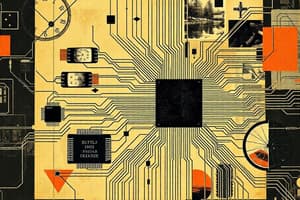Podcast
Questions and Answers
What is the classification of germanium, silicon, and carbon based on their electrical conductivity?
What is the classification of germanium, silicon, and carbon based on their electrical conductivity?
- Insulators
- Conductors
- Superconductors
- Semiconductors (correct)
What is the resistivity range of semiconductors compared to that of conductors and insulators?
What is the resistivity range of semiconductors compared to that of conductors and insulators?
- 10-2 to 100 Ωm
- 10-8 to 10-6 Ωm
- 10-5 to 10+4 Ωm (correct)
- 107 to 108 Ωm
Which group of the periodic table do Germanium and Silicon belong to?
Which group of the periodic table do Germanium and Silicon belong to?
- Group III
- Group IV (correct)
- Group I
- Group II
What are compound semiconductors formed from?
What are compound semiconductors formed from?
What is the resistivity of Germanium and Silicon?
What is the resistivity of Germanium and Silicon?
What does the arrow on the gate of a -channel JFET point?
What does the arrow on the gate of a -channel JFET point?
What is connected to each end of the -channel in an -channel JFET?
What is connected to each end of the -channel in an -channel JFET?
Where is the drain located in the basic structure of an -channel JFET?
Where is the drain located in the basic structure of an -channel JFET?
How many terminals does a JFET have?
How many terminals does a JFET have?
What is the structural difference between an -channel and a -channel JFET?
What is the structural difference between an -channel and a -channel JFET?
Flashcards
What are Semiconductors?
What are Semiconductors?
Materials with electrical conductivity between conductors and insulators.
Semiconductor Resistivity Range?
Semiconductor Resistivity Range?
Semiconductors' resistivity ranges from 10^-5 to 10^4 Ωm.
Germanium & Silicon Group?
Germanium & Silicon Group?
Germanium and Silicon belong to Group IV.
Compound Semiconductor Elements?
Compound Semiconductor Elements?
Signup and view all the flashcards
Resistivity of Ge & Si?
Resistivity of Ge & Si?
Signup and view all the flashcards
N-channel JFET Gate Arrow?
N-channel JFET Gate Arrow?
Signup and view all the flashcards
N-channel JFET connections?
N-channel JFET connections?
Signup and view all the flashcards
N-channel JFET Drain Location?
N-channel JFET Drain Location?
Signup and view all the flashcards
Number of JFET Terminals?
Number of JFET Terminals?
Signup and view all the flashcards
JFET Channel Arrow Difference?
JFET Channel Arrow Difference?
Signup and view all the flashcards
Study Notes
Introduction to FET
- FET (Field-Effect Transistor) is the second major type of transistor, unlike BJTs, FETs are unipolar devices operating with one type of charge carrier.
- There are two main types of FETs: Junction Field-Effect Transistor (JFET) and Metal Oxide Semiconductor Field-Effect Transistor (MOSFET).
Comparison with BJTs
- BJTs are current-controlled devices, whereas FETs are voltage-controlled devices.
- In BJTs, base current (IB) controls collector current (IC), whereas in FETs, voltage between gate and source terminals controls the current.
Characteristics of FETs
- FETs have very high input resistance.
JFET (Junction Field-Effect Transistor)
- JFET operates with a reverse-biased p-n junction to control the current in a channel.
- JFETs fall into two categories based on their structure: n-channel or p-channel.
Studying That Suits You
Use AI to generate personalized quizzes and flashcards to suit your learning preferences.




